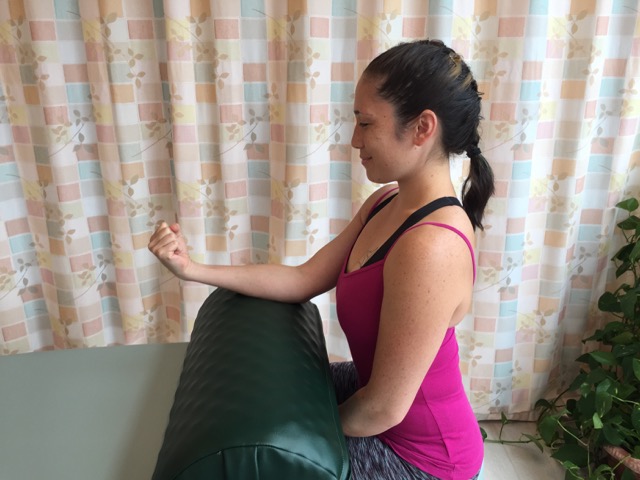Golfer’s Elbow – Introduction:
If tennis elbow has been learned (see blog posts on tennis elbow), it is easy to understand golfer’s elbow. Whereas tennis elbow involves the common extensor belly/tendon on the posterior side of the forearm at the lateral epicondyle of the humerus, golfer’s elbow involves the common flexor belly/tendon on the anterior side of the forearm at the medial epicondyle of the humerus. Whereas tennis elbow is caused to an overuse of the muscles of the common extensor tendon, golfer’s elbow is caused by an overuse of the muscles of the common flexor tendon. Whereas tennis elbow is also known as lateral epicondylitis or lateral epicondylosis, golfer’s elbow is also known as medial epicondylitis or medial epicondylosis. Just like tennis elbow, golfer’s elbow generally begins as an inflammatory condition of the common belly/tendon and epicondylar attachment, and then progresses to become a degenerative condition of the common tendon. And just like tennis is so named because playing tennis is often the cause, golfer’s elbow is so named because playing golf is often the cause.
The muscles of the common flexor tendon are the pronator teres, flexor carpi radialis, palmaris longus, flexor carpi ulnaris, and the flexor digitorum superficialis. Given that these muscles, as a group, flex the hand at the wrist joint and the fingers at the metacarpophalangeal and proximal interphalangeal joints, golfer’s elbow is caused by overuse of wrist and finger flexion. These joint actions are more common than wrist and finger extension, so theoretically, golfer’s elbow should occur more often than tennis elbow. However, because musculature of the common extensor tendon must also contract to stabilize the wrist joint when finger flexion is done, tennis elbow is the more common condition of the two.
Because the pathomechanics of golfer’s elbow are conceptually the same as tennis elbow, diagnosis/assessment and treatment strategy are essentially the same, except that they are applied to flexor musculature instead of extensor musculature. Therefore, active and passive ranges of motion and palpation are used to assess golfer’s elbow, and the same soft tissue manipulation strokes, stretching, and icing protocols are used for treatment. For these reasons, it might be helpful to look back at the previous blog posts on tennis elbow before reading these blogs on golfer’s elbow.
Note: Tennis elbow (see blog posts on tennis elbow) is a similar condition of the muscles/tendons (myofascial tissue) of the common extensor tendon at the lateral epicondyle of the humerus.
Causes of golfer’s elbow:

Flexing the hand at the wrist joint and/or the fingers engages muscles of the common flexor belly/tendon and can cause golfer’s elbow.
Golfer’s elbow is caused by an overuse of the muscles of flexion of the hand at the wrist joint and flexion of the fingers. Flexion of the fingers is involved in gripping objects, so any posture or activity that involves gripping and holding an object, such as a golf club or other object, can contribute to golfer’s elbow. Flexing the fingers is also ubiquitously used when typing on computers and other digital devices. Similarly, any posture or activity that involves flexing the wrist joint can contribute. Examples include swinging a golf club, hitting a serve in tennis, throwing a ball, playing piano, washing dishes, or brushing one’s hair. Any activity that requires isometric contraction of the wrist flexors to stabilize and prevent wrist extension would also engage and contract the wrist flexors. Hitting a forehand stroke in tennis requires isometric contraction of the wrist flexors to prevent the force of the ball hitting the racquet from collapsing the wrist joint into extension. Further, any time that a weight is held in the hand with the palm oriented upward requires isometric wrist flexor contraction to oppose gravity from collapsing the wrist joint into extension.
In addition to repeated microtraumatic overuse of the muscles of the common flexor tendon, a direct physical macrotrauma to the common flexor tendon or the medial epicondyle of the humerus, such as a bang, fall, or sudden powerful overstretch of the associated musculature (for example, falling on an outstretched hand) can also contribute to golfer’s elbow. Continual repeated friction of the medial epicondyle against a hard surface can also precipitate golfer’s elbow. This might occur when using a mouse at a computer and allowing the medial epicondyle to rub along the surface of the desk.
Click here for an article on the causes of tennis elbow.
Note: This is the first of five blog post articles on golfer’s elbow.
The five articles are:
- What are the causes of Golfer’s Elbow?
- What are the signs and symptoms of Golfer’s Elbow?
- How do we assess (diagnose) Golfer’s Elbow?
- How do we treat Golfer’s Elbow with manual therapy?
- What are the self-care and medical approaches to Golfer’s Elbow?


